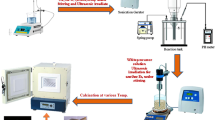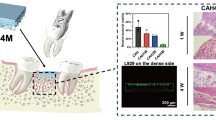Abstract
This work was mainly aimed to synthesize new ceramic composites based on nano-bioactive glass (nBG) and magnesium phosphate ceramic (MgP) with different ratios using the sol-gel approach in order to overcome the limitations of both materials. The glass was based on 85SiO2-10CaO-5P2O5 (mole %), and MgP was based on the formula; Mg3(PO4)2. The obtained composites were characterized by DTA, XRD, FTIR, SEM/EDX and Zeta potential techniques. The in vitro bioactivity test was carried out in SBF, and the cell viability test was conducted by culturing the composites with human normal fibroblast cell line (BJ1). The results of XRD analyses showed that there were often no strong diffraction peaks detected which indicated the amorphous nature of the ceramic composites. Moreover, soaking of the ceramic composites in SBF exhibited that addition of MgP to nBG was increased the degradation of the latter one, and nBG was improved the formation of apatite crystals on MgP ceramic. Moreover, the cell viability results showed that MgP was showed significant higher viability than nBG at high concentrations, and it improved the viability of nBG in the ceramic composites.
Similar content being viewed by others
References
Wang W, Yeung KW (2017) Bone grafts and biomaterials substitutes for bone defect repair: a review. Bioactive materials 2(4):224–247
Dimitriou R, Mataliotakis GI, Angoules AG, Kanakaris NK, Giannoudis PV (2011) Complications following autologous bone graft harvesting from the iliac crest and using the RIA: a systematic review. Injury 42:S3–S15
Giannoudis PV, Dinopoulos H, Tsiridis E (2005) Bone substitutes: an update. Injury 36(3):S20–S27
Zimmermann G, Moghaddam A (2011) Allograft bone matrix versus synthetic bone graft substitutes. Injury 42:S16–S21
LeGeros RZ (2008) Calcium phosphate-based osteoinductive materials. Chem Rev 108(11):4742–4753
Jongman Lee MMF (2014) Eui Kyun Park, Jiwon Lim, Hui-suk Yun, A simultaneous process of 3D magnesiumphosphate scaffold fabrication and bioactive substance loading for hard tissue regeneration. Mater Sci Eng C 36:52–260
M.M. Farag, H.-s.Y., Effect of gelatin addition on fabrication of magnesium phosphate-based scaffolds prepared by additive manufacturing system. Mater Lett, 2014. 132: p. 111–111, 115
Hench LL, Jones JR (2015) Bioactive glasses: frontiers and challenges. Frontiers in bioengineering and biotechnology 3:194
Bellucci D, Sola A, Anesi A, Salvatori R, Chiarini L, Cannillo V (2015) Bioactive glass/hydroxyapatite composites: mechanical properties and biological evaluation. Mater Sci Eng C 51:196–205
Moseke C, Saratsis V, Gbureck U (2011) Injectability and mechanical properties of magnesium phosphate cements. J Mater Sci Mater Med 22(12):2591–2598
Yu Y, Wang J, Liu C, Zhang B, Chen H, Guo H, Zhong G, Qu W, Jiang S, Huang H (2010) Evaluation of inherent toxicology and biocompatibility of magnesium phosphate bone cement. Colloids Surf B: Biointerfaces 76(2):496–504
Tamimi F, Nihouannen DL, Bassett DC, Ibasco S, Gbureck U, Knowles J, Wright A, Flynn A, Komarova SV, Barralet JE (2011) Biocompatibility of magnesium phosphate minerals and their stability under physiological conditions. Acta Biomater 7(6):2678–2685
Zreiqat H, Howlett CR, Zannettino A, Evans P, Schulze-Tanzil G, Knabe C, Shakibaei M (2002) Mechanisms of magnesium-stimulated adhesion of osteoblastic cells to commonly used orthopaedic implants. Journal of Biomedical Materials Research: An Official Journal of The Society for Biomaterials, The Japanese Society for Biomaterials, and The Australian Society for Biomaterials and the Korean Society for Biomaterials 62(2):175–184
Yamasaki Y, Yoshida Y, Okazaki M, Shimazu A, Uchida T, Kubo T, Akagawa Y, Hamada Y, Takahashi J, Matsuura N (2002) Synthesis of functionally graded MgCO3 apatite accelerating osteoblast adhesion. Journal of Biomedical Materials Research: An Official Journal of The Society for Biomaterials, The Japanese Society for Biomaterials, and The Australian Society for Biomaterials and the Korean Society for Biomaterials 62(1):99–105
Cao W, Hench LL (1996) Bioactive materials. Ceram Int 22(6):493–507
Hench LL, Splinter RJ, Allen WC, Greenlee TK (1971) Bonding mechanisms at the interface of ceramic prosthetic materials. J Biomed Mater Res 5(6):117–141
Ojansivu M, Vanhatupa S, Björkvik L, Häkkänen H, Kellomäki M, Autio R, Ihalainen JA, Hupa L, Miettinen S (2015) Bioactive glass ions as strong enhancers of osteogenic differentiation in human adipose stem cells. Acta Biomater 21:190–203
Balasubramanian P, Hupa L, Jokic B, Detsch R, Grünewald A, Boccaccini AR (2017) Angiogenic potential of boron-containing bioactive glasses: in vitro study. J Mater Sci 52(15):8785–8792
Vallet-Regí M, Ragel CV, Salinas AJ (2003) Glasses with medical applications. Eur J Inorg Chem 2003(6):1029–1042
Bellucci D, Sola A, Salvatori R, Anesi A, Chiarini L, Cannillo V (2014) Sol–gel derived bioactive glasses with low tendency to crystallize: synthesis, post-sintering bioactivity and possible application for the production of porous scaffolds. Mater Sci Eng C 43:573–586
Ostrowski N, Roy A, Kumta PN (2016) Magnesium phosphate cement systems for hard tissue applications: a review. ACS Biomaterials Science & Engineering 2(7):1067–1083
Kokubo T, Takadama H (2006) How useful is SBF in predicting in vivo bone bioactivity? Biomaterials 27(15):2907–2915
Bassyouni FA et al (2014) Synthesis and biological evaluation of some new triazolo [1, 5-a] quinoline derivatives as anticancer and antimicrobial agents. RSC Adv 4(46):24131–24141
Suzuki T, Yamamoto T, Toriyama M, Nishizawa K, Yokogawa Y, Mucalo MR, Kawamoto Y, Nagata F, Kameyama T (1997) Surface instability of calcium phosphate ceramics in tissue culture medium and the effect on adhesion and growth of anchorage-dependent animal cells. Journal of Biomedical Materials Research: An Official Journal of The Society for Biomaterials and The Japanese Society for Biomaterials 34(4):507–517
Ohgaki M, Kizuki T, Katsura M, Yamashita K (2001) Manipulation of selective cell adhesion and growth by surface charges of electrically polarized hydroxyapatite. Journal of Biomedical Materials Research: An Official Journal of The Society for Biomaterials, The Japanese Society for Biomaterials, and The Australian Society for Biomaterials and the Korean Society for Biomaterials 57(3):366–373
Teng N et al (2001) A new approach to enhancement of bone formation by electrically polarized hydroxyapatite. J Dent Res 80(10):1925–1929
Smith I, Baumann M, McCabe L (2004) Electrostatic interactions as a predictor for osteoblast attachment to biomaterials. Journal of Biomedical Materials Research Part A: An Official Journal of The Society for Biomaterials, The Japanese Society for Biomaterials, and The Australian Society for Biomaterials and the Korean Society for Biomaterials 70(3):436–441
Sarkar K, Rahaman M, Agarwal S, Bodhak S, Halder S, Nandi SK, Roy M (2020) Degradability and in vivo biocompatibility of doped magnesium phosphate bioceramic scaffolds. Mater Lett 259:126892
Wang Z, Ma Y, Wei J, Chen X, Cao L, Weng W, Li Q, Guo H, Su J (2017) Effects of sintering temperature on surface morphology/microstructure, in vitro degradability, mineralization and osteoblast response to magnesium phosphate as biomedical material. Sci Rep 7(1):823
Farag MM, Al-Rashidy ZM, Ahmed MM (2019) In vitro drug release behavior of Ce-doped nano-bioactive glass carriers under oxidative stress. J Mater Sci Mater Med 30(2):18
Jia J, Zhou H, Wei J, Jiang X, Hua H, Chen F, Wei S, Shin JW, Liu C (2010) Development of magnesium calcium phosphate biocement for bone regeneration. J R Soc Interface 7(49):1171–1180
Acknowledgements
This work was funded by Science and Technology Development Fund (STDF) under the project no. 24217. The authors would like to thank the National Research Centre (Biomaterials Group) and University of California Riverside, USA, for a possibility to use their facilities.
Author information
Authors and Affiliations
Corresponding author
Ethics declarations
Conflict of Interest
The authors declare that there have no conflicts of interest.
Additional information
Publisher’s Note
Springer Nature remains neutral with regard to jurisdictional claims in published maps and institutional affiliations.
Rights and permissions
About this article
Cite this article
Farag, M.M., Liu, H.H. & Makhlouf, A. New Nano-Bioactive Glass/Magnesium Phosphate Composites by Sol-Gel Route for Bone Defect Treatment. Silicon 13, 857–865 (2021). https://doi.org/10.1007/s12633-020-00485-3
Received:
Accepted:
Published:
Issue Date:
DOI: https://doi.org/10.1007/s12633-020-00485-3




